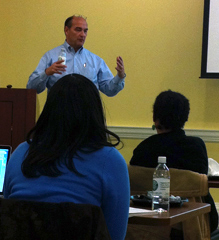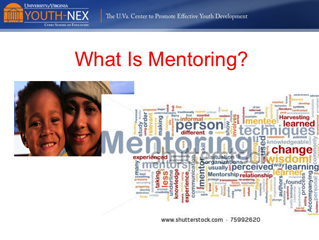Youth-Nex director Patrick Tolan, talks about “What Works in Mentoring?” at the recent YN Works In Progress meeting.
Reported by Youth-Nex Editors
Patrick H. Tolan is professor at the University of Virginia in the Curry School of Education and in the Department of Psychiatry and Neurobehavioral Sciences in the School of Medicine. He is director of the cross-University multidisciplinary center, Youth-Nex: The U.Va. Center to Promote Effective Youth Development.
Audio and slides are posted here.
Background, Questions, and Definitions
For 20 years we have known that mentoring can be beneficial, yet we still do not know much about what causes these benefits. Tolan discussed his study, the first meta-analysis to look at the processes inside mentoring.
What difference do mentoring activities like modeling, teaching, emotional support, and advocacy make? Is all mentoring positive?
Knowing how such programs work is important. Some popular social programs thrive and continue to receive funding despite the fact that they fail at producing the desired results. At the same time, we can spend 10 years doing empirical studies which do produce results. Despite this, we don’t fund or create programs based on proven interventions. Mentoring works and it is popular, so it’s important to learn how it works.
What is the definition of mentoring? What is the ‘magic’ of mentoring? How does it work? Do we have a good description of the mentoring “process?”
When asked, program developers and mentors are reluctant to specify how their mentoring relationships worked. It’s very difficult to determine just what is mentoring and what is not (is there anything that can not be called mentoring?). Tolan and colleagues first tried to define it within an intervention framework — what it was meant to do and how it was meant to work.
Mentoring is…
> One of the most common methods to prevent, divert, and remediate youth engaged in delinquent behavior.
Mentoring is a one-to-one relationship typically beneficial to the youth. Tolan et al think there are four processes that are common in mentoring:
1. Teaching
2. Emotional support
3. Advocacy
4. Modeling
These lead to changes in:
– Self image
– Attitudes
– Goals
– Behavior
…and through these changes, mentoring prevents or stems youth risk.
Mentoring is not: psychotherapy, skills building, informal care, parenting, teaching, tutoring….but it somewhat resembles each of those things.
Research
Tolan and fellow researchers conducted a meta-analysis and wrote two reports, “Mentoring Programs to Affect Delinquency and Associated Outcomes of Youth at Risk: A Comprehensive Meta-analytic Review,” published in the Journal of Experimental Criminology, and a more extensive Campbell Collaboration systematic review—”Mentoring Interventions to Affect Juvenile Delinquency and Associated Problems: A Systematic Review.”
All of the studies looked at were high quality (quasi-experimental or randomized experimental) in design. All involved youth at-risk for delinquency based on behavior of the youth or residing in high crime, high poverty communities.
Findings
Mentoring has effects on delinquency, substance use, aggression, and academic achievement of high risk youth.
– Emotional support and advocacy in mentoring made a significant difference in benefit level.
– Teaching had some indication of benefit. There was not a difference in effects by whether or not the program emphasized modeling.
– Also, if mentors were mentoring because it aided their professional development, the effects were more than when they volunteered for personal reasons.
Audio and Slides from the talk summarized above are posted here.


